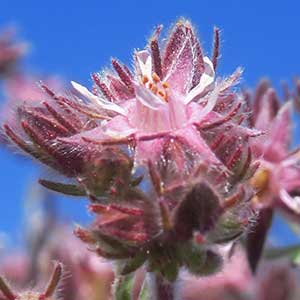Horkelia hendersonii
Horkelia sect. Hispidulae
Henderson's horkelia
ascending to erect, 0.8–2(–2.5) dm.
decumbent to erect, 0.3–2.5 dm.
3–8 × 0.7–1.5 cm;
leaflets (5 or)6–12 per side, overlapping at least distally, cuneate to flabellate, 4–9(–10) mm, divided 1/2+ to midrib into 3–6 oblanceolate to obovate lobes (often medially notched more than 3/4 to midrib as well), silky villous.
± cylindric to weakly planar;
stipules entire;
leaflets 4–14 per side, overlapping at least distally, divided 1/2–3/4+ to midrib into 3–8 lobes not restricted to apex.
2–3.
± congested, flowers arranged in dense corymbiform clusters.
2–8(–10) mm.
remaining straight, 2–8(–12) mm.
(2–)4–15(–20), 10 mm diam.;
epicalyx bractlets linear, 2.5–4.5 × 0.2–0.5 mm, 2/3 to nearly equal to length of sepals;
hypanthium 1–2.5 × (2–)3–4(–5) mm, ± 1/2 as deep as wide, interior densely villous;
sepals spreading, narrowly lanceolate, 3.5–6 mm, silky hairs silky, 1–1.5 mm;
petals often pink-tinged, linear to narrowly oblanceolate, 2.5–5 × 1 mm, apex ± acute to narrowly rounded, sometimes slightly mucronate;
filaments pinkish, 2 × 0.5–0.7 mm, glabrous or sparsely pilose adaxially, anthers 0.5–0.7 mm;
carpels 8–17;
styles (1.5–)2–3 mm.
epicalyx bractlets linear to lanceolate, 0.3–0.5(–0.8) mm wide, entire;
hypanthium interior sparsely pilose to densely villous;
sepals acute;
petals white, sometimes pink-tinged, narrowly oblanceolate to narrowly elliptic or oblong, apex usually acute to rounded to truncate, sometimes slightly mucronate or emarginate;
filaments white to pinkish, glabrous or sparsely pilose adaxially, anthers longer than wide;
carpels 5–18(–20).
dark brown, 2 mm.
1.5–2.5 mm, smooth.
Horkelia hendersonii
Horkelia sect. Hispidulae
Of conservation concern.
Horkelia hendersonii is one of the more attractive species of the genus, with its grayish mats and dusky pink inflorescences. P. A. Rydberg (1898) placed it initially in his group Capitatae, here restricted to H. fusca, and later (1908c) transferred it to his new group Tenuilobae, which otherwise comprised only H. tenuiloba. The species is known only from Jackson County, Oregon, and an isolated population in adjacent Siskiyou County, California. The populations are vulnerable due to their proximity to popular recreational sites.
(Discussion copyrighted by Flora of North America; reprinted with permission.)
Species 3 (3 in the flora).
Section Hispidulae accommodates three widely separated, localized species, with plants all forming tight, densely hairy mats in rocky sites at elevations of 2000 to 3400 m in the White Mountains, southern Sierra Nevada, and Siskiyou Mountains of California, adjacent Nevada, and southwestern Oregon.
When describing Horkelia tularensis (as Potentilla tularensis), Howell compared it to H. hispidula with the speculation that these interior species bordering the Great Basin were relicts of an evolutionary line distinct from the more coastal species. Given the geographic proximity to Horkeliella, which serves as a morphologic bridge between Horkelia and Ivesia, it is possible that sect. Hispidulae represents the relictual ancestral radiation within the genus.
(Discussion copyrighted by Flora of North America; reprinted with permission.)
1. Sepals narrowly lanceolate, with silky hairs 1–1.5 mm; hypanthium interior densely villous; petals often pink-tinged; Siskiyou Mountains, California and Oregon. | H. hendersonii |
1. Sepals broadly lanceolate, with stiff hairs 0.5–1 mm; hypanthium interior sparsely pilose; petals not pink-tinged; Sierra Nevada and White Mountains, California and Nevada | → 2 |
2. Basal leaves: leaflets 4–6(–10) per side; cauline leaves 1 or 2; carpels 5–12; s Sierra Nevada. | H. tularensis |
2. Basal leaves: leaflets (6–)10–14 per side; cauline leaves 3–7; carpels (10–)12–18(–20); White Mountains. | H. hispidula |


